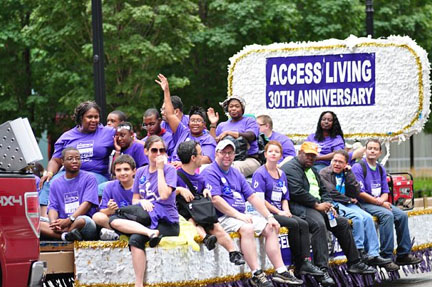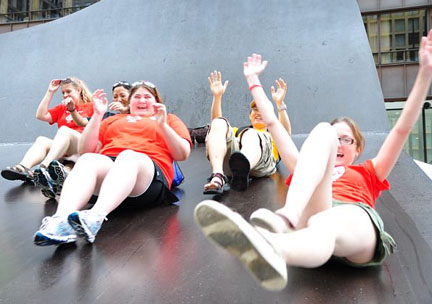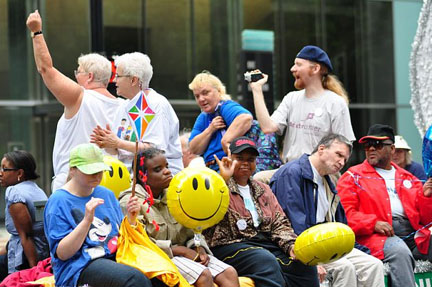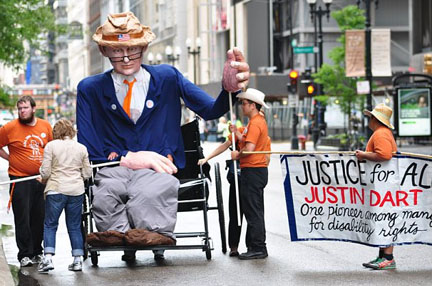| « Win Tickets To Screenings at the Chicago United Film Fest | "My Boys" I Hardly Knew Ye » |
Feature Tue Sep 14 2010
Home is Where the Pride Is

This story was submitted by Gapers Block Book Club and Drive-Thru writer, Ruthie Kott. All photos in this article were taken by Louis Terry.
The Chicago Temple's Dixon Chapel was packed for the July 23 open mic the night before the seventh annual Chicago Disability Pride Parade, and the food at the back of the room was just crumbs by the time Eli Clare got up to the microphone. His was the last performance of the night, and people were excited to hear him speak. When he introduced one of his poems, "How to Talk to a New Lover About Cerebral Palsy," the audience laughed. "I know that I'm home when people laugh," said Clare, a writer and speaker who was born with CP. When he shares the poem with more able-bodied audiences, he said, they just look sad.
He started to read: "Tell her: Complete strangers / have patted my head, kissed / my cheek, called me courageous." And when he got to the part about the woman asking about the difference between CP and MS--"refrain from handing her an encyclopedia"--the audience in the room laughed again. Clare briefly interrupted the poem. "Yeah, I'm home," he said, smiling.
Clare, a disability-rights and LGBTQ activist, was the 2010 parade's grand marshal. Living in Vermont's Green Mountains, he says, "I've made home in the disability community for nearly 25 years, and to be honored by that community in this way is bigger than I can express in words." It's a burgeoning community, one that's only recently begun to discover its voice, and Chicago, with the first disability-studies PhD program in the world at the University of Illinois at Chicago, is a center for disability-rights activism. People come from all over the region to participate in the parade, also the first of its kind in the world--in the past, there have been groups from Norway (they've since started a disability pride parade in Oslo), and this year there was a contingent from Korea.

The parade has evolved since its first showing in 2004. Started by Sarah Triano, then a program director at Access Living, Illinois's first independent-living center, the 2004 parade was held behind Solider Field. But the grass made it difficult for those in wheelchairs to get around. The 2005 parade was moved to the West Loop; participants marched down Randolph Street, but, as Disability Pride Parade Association president Janice Stashwick remembers, they ended up in Union Park for the rally: more grass. The parade was moved downtown the third year, thanks to an idea from Dan Van Hecke, founder of the Rehabilitation Institute of Chicago's accessible taxi program (he died in 2008), who was a cochair at that time. "So we negotiated with the city," says Stashwick, "and we got downtown. Since then, the parade has marched from Van Buren, down Dearborn, to Daley Plaza, where the rally is held. "People love it because it's flat," says Stashwick.
One thing had remained consistent through the years: despite the uncertainty of Chicago late-summers, the "weather gods" had smiled down on them, says Earl Smith, the 2010 parade's communications and outreach coordinator--the sun had always been shining. This year the weather gods weren't smiling quite as much, though: road closures and flooding kept some people, such as Smith's polio support group, from making it to the parade. Carrie Kaufman, representing disability-awareness clothing company 3E Love, was the only person who made it from her contingent. It was disappointing, she says; they would have made a lot of money selling the T-shirts with 3E Love's trademarked logo, a stick figure sitting in a wheelchair shaped like a heart.

But the weather gods weren't frowning either. The rain stopped by the time the parade started, and the sun was out completely by noon, the start of the rally--which featured blues musician Willie Williams, the Jesse White Tumblers, special-needs dance troupe Collective Sole, and speakers such as disability activist Rene David Luna. The University of Illinois at Chicago group handed out fans to rally-goers, and people fanned their programs to stay cool. Another group was giving out free water. When people needed a break from sun, they'd sit in the tents around the perimeter of Daley Plaza.
Like other identity-based parades, the Disability Pride Parade is about being seen, about a group of people who've been made to feel hidden and oppressed coming forward and saying, "We are here!" Triano, who now directs the Silicon Valley Independent Living Center in San Jose, CA, defined disability pride in the 2006 Encyclopedia of Disability, now reprinted on the parade's website: "Pride represents a rejection of the notion that our physical, sensory, mental, and cognitive differences from the non-disabled standard are wrong or bad in any way, and is a statement of our self-acceptance, dignity and pride." It's an act of fighting back against "the history of institutionalization and people with disabilities being kept in private, secluded areas of life," says Kate Caldwell, a student in UIC's disability-studies PhD program. In addition to self-identifying as a disabled person or advocate, she says, feeling proud of being a part of that group and physically coming together to share that pride is a necessary part of building that community. Clare agrees: "Pride is about community," he says. "It's about building a strong, vibrant, rebellious community."

Clare's involvement in this year's parade represents the intersection of other pride movements. A transgender man who identifies as "genderqueer"--"I've maintained this internal sense of being neither a woman nor a man"--Clare says that part of the way he comes to pride is through queer pride. But he doesn't expect, or want, the Disability Pride Parade to turn into the gay pride parade. "LGBT pride for the last ten years has become very commercialized," he says, and more apolitical. "Those two things aren't necessarily good, particularly for an activist like me who really wants to see broad-based social change." Instead, says Clare, "what I would like to see disability pride be doing is making connections between people doing prison justice work and people doing disability justice work. I would like to hear people talking about racism, sexism, poverty, and homophobia and transphobia." The parade should not be just about disability rights, as Clare and many of the rally speakers made clear: it should be about human rights.
The parade is also about celebrating civil-rights milestones like the 20th anniversary of the Americans With Disabilities Act, signed in 1990--one of this year's floats, which came from Detroit's Matrix Theatre Company, was a giant puppet of Justin Dart, considered one of the fathers of the ADA. The company members honored Dart's battle cry, "Lead on," as they marched, singing, "I've got that 'lead on' feeling deep in my heart, deep in my heart, deep in my heart. I've got that lead on deep in my heart, deep in my heart to stay..."
But milestones for individual populations also are recognized and supported by other members of the disability community at the parade, where many different groups with different identities come together under one "disability pride" umbrella. At this year's open mic, the 2009 parade grand marshal, Amber Smock, shared exciting news for the deaf community: "This week," she said, they won a "victory overdue for 130 years." At the Second International Congress on Education of the Deaf in 1880, she explained, a resolution was passed to ban sign language in favor of oral education, although, she explained, ultimately the 21st full session of the ICED finally rejected that resolution. It's one step forward, said Smock, who identifies as deaf but was educated orally in mainstream schools. "One more step away from being hidden and oppressed." The whole crowd--those who were deaf and those who weren't--in the room clapped and cheered.

To identify as a community, says UIC PhD student in disability studies and UIC-contingent marcher Ryan Parrey-Munger, "you have to ignore your differences completely," something that isn't easy with such a diverse group of people. Before coming to UIC, says Parrey-Munger, who has a visual impairment, "I had very little experience or exposure to the idea of disability, of other people with disabilities, and of people with other disabilities." But at the school, within the first six months, he says, "it was just extremely consciousness-raising... I think that is what's so exciting about the parade. It's not just awareness for the nondisabled public, but for the mass of disabled people" who realize, "'Oh wow, I'm not alone.'"
Because of programs like UIC's, as well as the many active Chicago-based disability-rights organizations like Access Living, feminist group FRIDA, and Chicago ADAPT, which preaches civil disobedience--all of which have participated in the parades--the city's disability community feels relatively close-knit. Many people from different organizations seem to know each other. Before the open mic, as I was interviewing Janice Stashwick and Earl Smith, at least ten people came over to say hello, and others waved as they exited the elevator. Later, Smock recalled the first open mic in 2004, with half the number of people in a room at UIC. "A lot more people have joined the movement" since then, she said. "I see a lot of new friends I've made, people with all kinds of disabilities."
There's something exciting about being a part of a group of people where everybody is celebrating something they have in common. That "something" is hard to define, especially for such a diverse group, but Parrey-Munger and his wife, Kelly, also a UIC disability-studies PhD student, seem to get at what it might be when they talk hypothetically about moving to, say, Wyoming. There, they likely wouldn't be surrounded by people in the disability community as they are here. "In the department at UIC," says Parrey-Munger, and "in the group of disability community people that we know, you don't have to explain that part of yourself. You might have to explain other parts, but that part they get."

The idea of understanding, of being able to be in a group of people without anyone asking questions of you, is something Gary Arnold, public-relations coordinator at Access Living and a 2010 parade committee member, can also relate to. At the open mic, Arnold's wife, Katie, a disability-studies master's student, told a story about one evening at Millennium Park, where she and Arnold, who's a little person, went to enjoy a concert and a picnic. Katie, dancing by herself, tried to get Arnold to join her, but he refused--he had mentioned in an interview that his biggest fear is ending up on YouTube. But, at the rally in Daley Plaza, as Willie Williams sang about "Sweet Home Chicago," Arnold danced in a group of people up at the front of the stage.
The parade allows people who have to put up with prejudice on a daily basis to feel at home with others who understand them. "Pride refuses to let the daily grind of discrimination, exclusion, violence and patronizing define who we are," Clare writes in a statement. Stashwick agrees and finds that pride in fact empowers those who feel it: "If I believe I am worthy and if I expect the dignity that everyone deserves, then I'm going to be more apt to fight for my rights," she says. "When you feel this pride is when you're going to metaphorically stand up and say, 'Look at me. I'm a person. I deserve it.'"









Amber Smock / September 14, 2010 11:26 AM
This is one of the best pieces I have ever seen written about the Parade. It dies a great job of talking about all the different issues and interests that come together on the day of the Parade---and that intersect each day of the year in multiple ways.